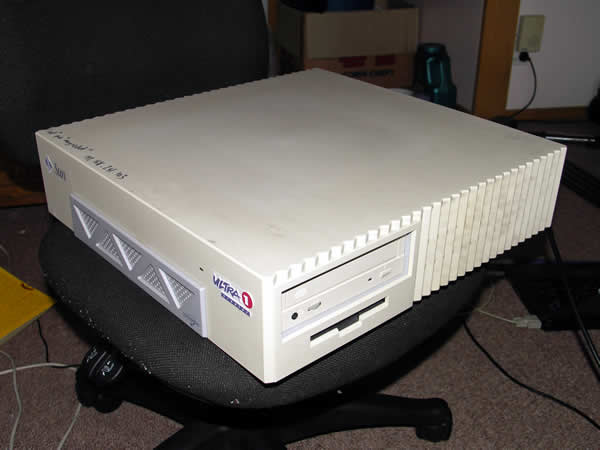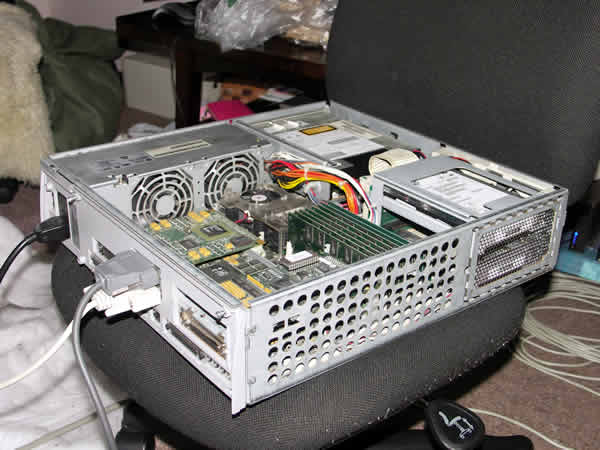So last night I almost tripped over on my way into the 24 hour computer lab. I was almost going to pass it by, but then I noticed the attractive sawtooth pattern on the side of the side and thought "that looks like a SUN!" Turns out it was a Sun Ultra Creator 1, a variant of the Sun Ultra 1 workstation.
So soon after I was cycling home with a 12 kilo [1, pp 5-2] workstation strapped on the back of my bike, going clunk every time I went over a bump. The extra 12 kg over the back wheel is excellent resistance training by the way.

Specs
- Processor: UltraSPARC 167MHz
- Memory: 256 MB
- Ethernet: Built in 10baseT
- UPA Slot 1e,0: SUNW, ffb
- Sbus 0,0: QLGC,isp sd st (some kind of QLOGIC SCSI card)
- Sbus 1,0: Performance Technologies SBS430 Fast, Narrow SCSI host bus adapter (identified as dma ptscII PTI,sbs430)[2]
- Hard drive: None supplied, now fitted with a 4.3 Gb Quantum Baracuda SCSI drive. Uses an 80 pin SCA connector, room for 2 drives, has hot plug trays.
- SCSI CD Drive
- Floppy drive (SCSI?) — mac-like soft eject
- A selection of noisy and 95% dead fans, most with noisy bearings

Serial Console
Like all Unix machines worth their weight, Sun's have built in support for serial consoles. Of course getting this to work is easier said than done. In this case, it required a 25 pin male to 9 pin female null-modem cable. I had everything but. So we used the following cables: 25M to 9F + 9M to 9M + 9F to 9F. All but the last cable were straight through; the final was a null-modem cable.
The magic settings on the terminal emulator (Term Term [3]) are:
- Speed: 9600 bps
- Data: 8 bit
- Parity: none
- Stop bits: 1 bit
- Flow control: Xon/Xoff
The flow control was the tricky bit and took me a while to track down. Also, I changed the internal jumper settings on J2104 and J2105 to pins 1-2 each to specify RS-232 (+/- 12 V signals) instead of the default RS-423 (+/- 5 V signals). I am not sure how important this step is [1, pp 4-3].
Boot Output
To get it working, simply plug everything together, fire up your terminal emulator and turn on the Sun. Here is a segment of the very verbose output:
@(#) Sun Ultra 1 UPA/SBus 3.0 Version 4 created 1995/11/26 17:57
Clearing E$ Tags Done
Clearing I/D TLBs Done
Probing Memory Done
MEM BASE = 0000.0000.3000.0000
MEM SIZE = 0000.0000.0400.0000
MMUs ON
Copy Done
PC = 0000.01ff.f000.1a7c
PC = 0000.0000.0000.1ac0
Decompressing into Memory Done
Size = 0000.0000.0007.00b0
ttya initialized
SC Control: EWP:0 IAP:0 FATAL:0 WAKEUP:0 BXIR:0 BPOR:0 SXIR:0 SPOR:1 POR:0
Incorrect configuration checksum;
Setting NVRAM parameters to default values.
Setting diag-switch? NVRAM parameter to true
Probing Memory Bank #0 32 + 32 : 64 Megabytes
Probing Memory Bank #1 32 + 32 : 64 Megabytes
Probing Memory Bank #2 32 + 32 : 64 Megabytes
Probing Memory Bank #3 32 + 32 : 64 Megabytes
Probing UPA Slot at 1e,0 SUNW,ffb
Probing /sbus@1f,0 at 0,0 QLGC,isp sd st
Probing /sbus@1f,0 at 1,0 dma ptscII PTI,sbs430
SC Control: EWP:0 IAP:0 FATAL:0 WAKEUP:0 BXIR:0 BPOR:0 SXIR:0 SPOR:1 POR:0
Incorrect configuration checksum;
Setting NVRAM parameters to default values.
Setting diag-switch? NVRAM parameter to true
Probing Memory Bank #0 32 + 32 : 64 Megabytes
Probing Memory Bank #1 32 + 32 : 64 Megabytes
Probing Memory Bank #2 32 + 32 : 64 Megabytes
Probing Memory Bank #3 32 + 32 : 64 Megabytes
Probing UPA Slot at 1e,0 SUNW,ffb
Probing /sbus@1f,0 at 0,0 QLGC,isp sd st
Probing /sbus@1f,0 at 1,0 dma ptscII PTI,sbs430
Sun Ultra 1 UPA/SBus (UltraSPARC 167MHz), No Keyboard
OpenBoot 3.0, 256 MB memory installed, Serial #10468415.
Ethernet address 9e:bf:af:eb:ec:be, Host ID: af9fbc3f.
The IDPROM contents are invalid
Boot device: net File and args:
Internal loopback test -- Did not receive expected loopback packet.
Evaluating: boot
Can't open boot device
Clearing E$ Tags Done
Clearing I/D TLBs Done
Probing Memory Done
MEM BASE = 0000.0000.3000.0000
MEM SIZE = 0000.0000.0400.0000
MMUs ON
Copy Done
PC = 0000.01ff.f000.1a7c
PC = 0000.0000.0000.1ac0
Decompressing into Memory Done
Size = 0000.0000.0007.00b0
ttya initialized
SC Control: EWP:0 IAP:0 FATAL:0 WAKEUP:0 BXIR:0 BPOR:0 SXIR:0 SPOR:1 POR:0
Incorrect configuration checksum;
Setting NVRAM parameters to default values.
Setting diag-switch? NVRAM parameter to true
Probing Memory Bank #0 32 + 32 : 64 Megabytes
Probing Memory Bank #1 32 + 32 : 64 Megabytes
Probing Memory Bank #2 32 + 32 : 64 Megabytes
Probing Memory Bank #3 32 + 32 : 64 Megabytes
Probing UPA Slot at 1e,0 SUNW,ffb
Probing /sbus@1f,0 at 0,0 QLGC,isp sd st
Probing /sbus@1f,0 at 1,0 dma ptscII PTI,sbs430
SC Control: EWP:0 IAP:0 FATAL:0 WAKEUP:0 BXIR:0 BPOR:0 SXIR:0 SPOR:1 POR:0
Incorrect configuration checksum;
Setting NVRAM parameters to default values.
Setting diag-switch? NVRAM parameter to true
Probing Memory Bank #0 32 + 32 : 64 Megabytes
Probing Memory Bank #1 32 + 32 : 64 Megabytes
Probing Memory Bank #2 32 + 32 : 64 Megabytes
Probing Memory Bank #3 32 + 32 : 64 Megabytes
Probing UPA Slot at 1e,0 SUNW,ffb
Probing /sbus@1f,0 at 0,0 QLGC,isp sd st
Probing /sbus@1f,0 at 1,0 dma ptscII PTI,sbs430
Sun Ultra 1 UPA/SBus (UltraSPARC 167MHz), No Keyboard
OpenBoot 3.0, 256 MB memory installed, Serial #10468415.
Ethernet address 9e:bf:af:eb:ec:be, Host ID: af9fbc3f.
The IDPROM contents are invalid
Boot device: net File and args:
Internal loopback test -- Did not receive expected loopback packet.
Evaluating: boot
Can't open boot device
OS
Since the hard drives were removed before being made free (though the root password and IP address are still written in Sharpie on the case!), no OS is installed on this machine. Since I'm a Debian boy through and trough, there really is only one choice.
To install Debian, one needs to download the Sparc Debian Netinstall ISO and burn, then boot from it. On Sarah I had to enter:
ok boot cdrom
... and then we were off to a flying start. Installation proceeded very smoothly and quickly, presenting no major problems. Once rebooted I had to tell it to boot from the hard drive with:
ok boot disk0:a
To set the default boot device, use the following command:
ok setenv boot-device device[n]
References
[1] — Sun Ultra 1 Creator Series Reference Manual, SUN Microsystems, September 1995.
[2] — SBS430 Fast, Narrow SCSI host bus adapter for Sbus, Performance Technologies, accessed on 31/Oct/2006.
[3] — Term Term, hp.vector.co.jp/authors/VA002416/teraterm.html.